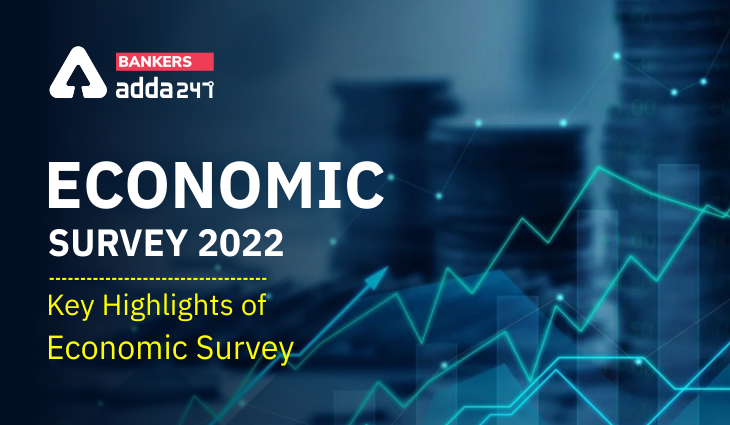Finance Minister, Nirmala Sitharaman has presented Economic Survey 2021-22 in the Parliament on 31st January 2022. The pre-budget Economic Survey, which is tabled in Parliament ahead of the Union Budget to present the state of the economy and suggest policy prescriptions. The pre-Budget Economic Survey is authored by a team led by Chief Economic Advisor (CEA). Days before the presentation, the Centre appointed economist V Anantha Nageswaran as the new CEA.
Buy Prime Test Series for all Banking, SSC, Insurance & other exams
What is the Economic Survey?
- Economic Survey is an annual document of the Ministry of Finance. It reviews the economic progress of the country and issues in the last 12 months.
- The survey provides information related to the performance of key developmental schemes launched by the government. The document also explains the performance of major government policies and their impact.
- The Economic Survey discusses major fiscal developments, macroeconomic factors, inflation, and other economic factors. The document also highlights the impact of agriculture, climate change, and employment on the economy of the country.
- The 1st Economic Survey was tabled in 1950-51. However, till the year 1964, it was presented along with the budget.
Here are the key highlights from the Economic Survey 2021-22:
The government sees the Indian economy growing at 8-8.5 per cent in the financial year 2022-23 (FY23). The GDP growth rate for the ongoing financial year 2021-22 (FY22) is estimated at 9.2 per cent. In order to achieve USD 5 trillion GDP by FY’25, India needs to spend about USD 1.4 trillion over this period on infrastructure, according to the Economic Survey.
The main reason for the lower forecast is the non-availability of significant base effects in 2022-23 as compared to 2021-22. In fact, when these base effects were absent in Q3 and Q4 of 2021-22 and economic activities had started to normalize, the average growth in the second half of 2021-22 was only 5.6%.
State of the Economy:
- Indian economy is estimated to grow by 9.2 per cent in real terms in 2021-22 (as per first advanced estimates) subsequent to a contraction of 7.3 per cent in 2020-21.
- GDP is projected to grow by 8- 8.5 per cent in real terms in 2022-23.
- The year ahead is poised for a pickup in private sector investment with the financial system in a good position to provide support for the economy’s revival.
- The projection was comparable with World Bank and Asian Development Bank’s latest forecasts of real GDP growth of 8.7 per cent and 7.5 per cent respectively for 2022-23.
- As per IMF’s latest World Economic Outlook projections, India’s real GDP is projected to grow at 9 per cent in 2021-22 and 2022-23 and at 7.1 per cent in 2023-2024, which would make India the fastest-growing major economy in the world for all 3years.
- Agriculture and allied sectors are expected to grow by 3.9 per cent; industry by 11.8 per cent and the services sector by 8.2 per cent in 2021-22.
- On-demand side, consumption is estimated to grow by 7.0 percent, Gross Fixed Capital Formation (GFCF) by 15 per cent, exports by 16.5 percent and imports by 29.4 percent in 2021-22.
- Macroeconomic stability indicators suggest that the Indian Economy is well placed to take on the challenges of 2022-23.
- Combination of high foreign exchange reserves sustained foreign direct investment, and rising export earnings will provide an adequate buffer against possible global liquidity tapering in 2022-23.
- The economic impact of the “second wave” was much smaller than that during the full lockdown phase in 2020-21, though the health impact was more severe.
- Government of India’s unique response comprised of safety-nets to cushion the impact on vulnerable sections of society and the business sector, significant increase in capital expenditure to spur growth and supply-side reforms for a sustained long-term expansion.
- The government’s flexible and multi-layered response is partly based on an “Agile” framework that uses feedback-loops, and the use of eighty High-Frequency Indicators (HFIs) in an environment of extreme uncertainty.
Fiscal Developments:
- The revenue receipts from the Central Government (April to November 2021) have gone up by 67.2 per cent (YoY) as against the expected growth of 9.6 per cent in the 2021-22 Budget Estimates (over 2020-21 Provisional Actuals).
- Gross Tax Revenue registers a growth of over 50 per cent during April to November 2021 in YoY terms. This performance is strong compared to pre-pandemic levels of 2019-2020 also.
- During April-November 2021, Capex has grown by 13.5 per cent (YoY) with a focus on infrastructure-intensive sectors.
- Sustained revenue collection and a targeted expenditure policy have contained the fiscal deficit for April to November 2021 at 46.2 per cent of BE.
- With the enhanced borrowings on account of COVID-19, the Central Government debt has gone up from 49.1 per cent of GDP in 2019-20 to 59.3 per cent of GDP in 2020-21 but is expected to follow a declining trajectory with the recovery of the economy.
External Sectors:
- India’s merchandise exports and imports rebounded strongly and surpassed pre-COVID levels during the current financial year.
- There was a significant pickup in net services with both receipts and payments crossing the pre-pandemic levels, despite weak tourism revenues.
- Net capital flows were higher at US$ 65.6 billion in the first half of 2021-22, on account of continued inflow of foreign investment, revival in net external commercial borrowings, higher banking capital and additional special drawing rights (SDR) allocation.
- India’s external debt rose to US $ 593.1 billion at the end-September 2021, from the US $ 556.8 billion a year earlier, reflecting additional SDR allocation by IMF, coupled with higher commercial borrowings.
- Foreign Exchange Reserves crossed US$ 600 billion in the first half of 2021-22 and touched the US $ 633.6 billion as of December 31, 2021.
- As of end-November 2021, India was the fourth-largest forex reserves holder in the world after China, Japan and Switzerland.
Monetary Management and Financial Intermediation:
- The liquidity in the system remained in surplus.
- Repo rate was maintained at 4 per cent in 2021-22.
- RBI undertook various measures such as G-Sec Acquisition Programme and Special Long-Term Repo Operations to provide further liquidity.
The economic shock of the pandemic has been weathered well by the commercial banking system:
- YoY Bank credit growth accelerated gradually in 2021-22 from 5.3 per cent in April 2021 to 9.2 per cent as on 31st December 2021.
- The Gross Non-Performing Advances ratio of Scheduled Commercial Banks (SCBs) declined from 11.2 per cent at the end of 2017-18 to 6.9 per cent at the end of September 2021.
- Net Non-Performing Advances ratio declined from 6 per cent to 2.2 per cent during the same period.
- The capital to risk-weighted asset ratio of SCBs continued to increase from 13 per cent in 2013-14 to 16.54 per cent at the end of September 2021.
- The Return on Assets and Return on Equity for Public Sector Banks continued to be positive for the period ending September 2021.
Exceptional year for the capital markets:
- Rs. 89,066 crores were raised via 75 Initial Public Offering (IPO) issues in April-November 2021, which is much higher than in any year in the last decade.
- Sensex and Nifty scaled up to a touching peak at 61,766 and 18,477 on October 18, 2021.
- Among major emerging market economies, Indian markets outperformed peers in April-December 2021.
Prices and Inflation:
- The average headline CPI-Combined inflation moderated to 5.2 per cent in 2021-22 (April-December) from 6.6 per cent in the corresponding period of 2020-21.
- The decline in retail inflation was led by easing of food inflation.
- Food inflation averaged at a low of 2.9 per cent in 2021-22 (April to December) as against 9.1 per cent in the corresponding period last year.
- Effective supply-side management kept prices of most essential commodities under control during the year.
- Proactive measures were taken to contain the price rise in pulses and edible oils.
- Reduction in central excise and subsequent cuts in Value Added Tax by most States helped ease petrol and diesel prices.
Wholesale inflation based on the Wholesale Price Index (WPI) rose to 12.5 per cent during 2021-22 (April to December). This has been attributed to:
- Low base in the previous year,
- Pick-up in economic activity,
- The sharp increase in international prices of crude oil and other imported inputs, and
- High freight costs.
The divergence between CPI-C and Wholesale price index Inflation:
- The divergence peaked to 9.6 percentage points in May 2020.
- However, this year there was a reversal in divergence with retail inflation falling below wholesale inflation by 8.0 percentage points in December 2021.
This divergence can be explained by factors such as:
- Variations due to base effect,
- The difference in scope and coverage of the two indices,
- Price collections,
- Items covered,
- The difference in commodity weights, and
- The wholesale price index being more sensitive to cost-push inflation led by imported inputs.
With the gradual waning of the base effect in WPI, the divergence in CPI-C and WPI is also expected to narrow down.
Sustainable Development and Climate Change:
- India’s overall score on the NITI Aayog SDG India Index and Dashboard improved to 66 in 2020-21 from 60 in 2019-20 and 57 in 2018-19.
- The number of Front Runners (scoring 65-99) increased to 22 States and UTs in 2020-21 from 10 in 2019-20.
- In North-East India, 64 districts were Front Runners and 39 districts were Performers in the NITI Aayog North-Eastern Region District SDG Index 2021-22.
- India has the tenth largest forest area in the world.
- In 2020, India ranked third globally in increasing its forest area from 2010 to 2020.
- In 2020, the forests covered 24% of India’s total geographical, accounting for 2% of the world’s total forest area.
- In August 2021, the Plastic Waste Management Amendment Rules, 2021, was notified which is aimed at phasing out single-use plastic by 2022.
- Draft regulation on Extended Producer Responsibility for plastic packaging was notified.
- The Compliance status of Grossly Polluting Industries (GPIs) located in the Ganga main stem and its tributaries improved from 39% in 2017 to 81% in 2020.
- The consequent reduction in effluent discharge has been from 349.13 million litres per day (MLD) in 2017 to 280.20 MLD in 2020.
- The Prime Minister, as a part of the national statement delivered at the 26th Conference of Parties (COP 26) in Glasgow in November 2021, announced ambitious targets to be achieved by 2030 to enable further reduction in emissions.
- The need to start the one-word movement ‘LIFE’ (Lifestyle for Environment) urging mindful and deliberate utilization instead of mindless and destructive consumption was underlined.
Agriculture and Food Management:
- The Agriculture sector experienced buoyant growth in past two years, accounting for a sizeable 18.8% (2021-22) in Gross Value Added (GVA) of the country registering a growth of 3.6% in 2020-21 and 3.9% in 2021-22.
- Minimum Support Price (MSP) policy is being used to promote crop diversification.
- Net receipts from crop production have increased by 22.6% in the latest Situation Assessment Survey (SAS) compared to SAS Report of 2014.
- Allied sectors including animal husbandry, dairying and fisheries are steadily emerging to be high growth sectors and major drivers of overall growth in agriculture sector.
- The Livestock sector has grown at a CAGR of 8.15% over the last five years ending 2019-20. It has been a stable source of income across groups of agricultural households accounting for about 15% of their average monthly income.
- Government facilitates food processing through various measures of infrastructure development, subsidized transportation and support for the formalization of micro food enterprises.
- India runs one of the largest food management programmes in the world.
- The government has further extended the coverage of food security networks through schemes like PM Gareeb Kalyan Yojana (PMGKY).
Industry and Infrastructure:
- Index of Industrial Production (IIP) grew at 17.4 per cent (YoY) during April-November 2021 as compared to (-)15.3 per cent in April-November 2020.
- Capital expenditure for the Indian railways has increased to Rs. 155,181 crores in 2020-21 from an average annual of Rs. 45,980 crores during 2009-14 and it has been budgeted to further increase to Rs. 215,058 crores in 2021-22 – a five times increase in comparison to the 2014 level.
- The extent of road construction per day increased substantially in 2020-21 to 36.5 Kms per day from 28 Kms per day in 2019-20 – a rise of 30.4 per cent.
- Net profit to sales ratio of large corporates reached an all-time high of 10.6 per cent in the July-September quarter of 2021-22 despite the pandemic (RBI Study).
- Introduction of Production Linked Incentive (PLI) scheme, the major boost provided to infrastructure-both physical as well as digital, along with measures to reduce transaction costs and improve ease of doing business, would support the pace of recovery.
Services:
- GVA of services crossed pre-pandemic level in July-September quarter of 2021-22; however, GVA of contact intensive sectors like trade, transport, etc. still remain below pre-pandemic level.
- Overall service Sector GVA is expected to grow by 8.2 per cent in 2021-22.
- During April-December 2021, rail freight crossed its pre-pandemic level while air freight and port traffic almost reached their pre-pandemic levels, domestic air and rail passenger traffic are increasing gradually – shows the impact of the second wave was much more muted as compared to during the first wave.
- During the first half of 2021-22, the service sector received over US$ 16.7 billion FDI – accounting for almost 54 per cent of total FDI inflows into India.
- IT-BPM services revenue reached US$ 194 billion in 2020-21, adding 1.38 lakh employees during the same period.
- Major government reforms include removing telecom regulations in the IT-BPO sector and opening up of space sector to private players.
- Services exports surpassed the pre-pandemic level in January-March quarter of 2020-21 and grew by 21.6 per cent in the first half of 2021-22 – strengthened by global demand for software and IT services exports.
- India has become 3rd largest start-up ecosystem in the world after US and China. The number of new recognized start-ups increased to over 14000 in 2021-22 from 733 in 2016-17.
- 44 Indian start-ups have achieved unicorn status in 2021 taking the overall tally of unicorns to 83, most of which are in the services sector.
Social Infrastructure and Employment:
- 157.94 crore doses of COVID-19 vaccines administered as on 16th January 2022; 91.39 crores first dose and 66.05 crores second dose.
- With the revival of the economy, employment indicators bounced back to pre-pandemic levels during the last quarter of 2020-21.
- As per the quarterly Periodic Labour Force Survey (PFLS) data up to March 2021, employment in the urban sector affected by pandemic has recovered almost to the pre-pandemic level.
- According to Employees Provident Fund Organisation (EPFO) data, formalization of jobs continued during the second COVID wave; the adverse impact of COVID on the formalization of jobs was much lower than during the first COVID wave.
- Expenditure on social services (health, education and others) by Centre and States as a proportion of GDP increased from 6.2 % in 2014-15 to 8.6% in 2021-22 (BE).
- Under Jal Jeevan Mission (JJM), 83 districts have become ‘Har Ghar Jal’ districts.
- Increased allotment of funds to Mahatma Gandhi National Rural Employment Guarantee Scheme (MNREGS) to provide a buffer for unorganized labour in rural areas during the pandemic.
As per the National Family Health Survey-5:
- Total Fertility Rate (TFR) came down to 2 in 2019-21 from 2.2 in 2015-16;
- Infant Mortality Rate (IMR), under-five mortality rate and institutional births have improved in 2019-21 over the year 2015-16.
Check More GK Updates Here
31st January | Current Affairs 2022 | Current Affairs Today | Current Affairs
Click Here to Register for Bank Exams 2021 Preparation Material
Visit Achieversadda.com and participate in discussions with other aspirants and achievers. Get answers to your queries and connect with others on Achieversadda.com
All the Best BA’ians for the Bank exam!





 Weekly Current Affairs One Liners 23rd t...
Weekly Current Affairs One Liners 23rd t...
 CSIR CRRI Typing Test 2025 Date for JSA ...
CSIR CRRI Typing Test 2025 Date for JSA ...
 Can Final Year Students Apply for SBI PO...
Can Final Year Students Apply for SBI PO...


